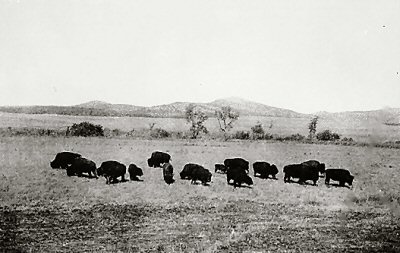People of the Bison
I found myself sitting in a park on a cold October day. The leaves
on the trees were full of color. Yellow trees to my left, red trees
to my right, and a mosaic of colors on the ground. The grass was a
deep green color, at least the areas not covered by leaves. The
swimming pool was drained and winterized, and the park benches were
all placed in the closest shelter house.
The playground equipment was different too. The swing sets looked
empty, because the swings were taken off for the winter. Springs
were stripped of their horses so they would not crack during the
cold winter. I didn’t need bug spray since it was too cold for
mosquitoes or gnats to bother me. The most important part of the
park was also missing, the kids. I didn’t notice any laughter or
tears, no cuts or scrapes, no running or tag, no swimming or hugs,
no friends and no fun. As I walked though the leaves, I uncovered a
flower protected by warmth, a reminder of the past season and a
glimpse of the future of good things to come when the seasons do
change.
Years ago bison covered the plains similar to new leaves on a spring
tree. They migrated with the seasonal change. They traveled north of
The Black Hills during t he summer and south of The Black Hills
during the winter. The movement of Native Americans coincided with
the bison migration. The Indians main source of food was the bison.
The Indians used every part of the bison because they respected the
animal and considered it very sacred. They used the meat for food,
the hide for warmth, the stomach to hold water and the bones for
tools and arrows. The survival and livelihood of the Indians
depended on the availability of the bison. The number of bison
during the 1600s was very abundant. It is estimated that during the
early 1600s there were 30 to 60 million buffalo. he summer and south of The Black Hills
during the winter. The movement of Native Americans coincided with
the bison migration. The Indians main source of food was the bison.
The Indians used every part of the bison because they respected the
animal and considered it very sacred. They used the meat for food,
the hide for warmth, the stomach to hold water and the bones for
tools and arrows. The survival and livelihood of the Indians
depended on the availability of the bison. The number of bison
during the 1600s was very abundant. It is estimated that during the
early 1600s there were 30 to 60 million buffalo.
There is an old saying that all good things come to an end.
Unfortunately, this was true for the Indians. No one ever imagined
the buffalo would almost become extinct by 1890. Just as leaves fall
from the trees before winter, the buffalo were disappearing from the
grassy plains. There was an increase in demand for the fur of the
buffalo. Millions of animals were slaughtered during the
1800s. The livelihood of the Indians as they knew it was gone. The
United States Government set up agencies on reservations where the
Indians could receive clothing, food, and shelter. Even the people
of Crazy Horse and Red Cloud had to come to lands set-aside for
them. It was either that, or starvation.
As for the people a hundred years ago who perhaps thought
reservations were places where American Indians would drop their
traditional ways…history proved them wrong. Just like we have seen
an increase in the population of buffalo today, we see old Indian
traditions still celebrated on reservations. Just like the bison,
the people of the bison are forever part of South Dakota.
|



 he summer and south of The Black Hills
during the winter. The movement of Native Americans coincided with
the bison migration. The Indians main source of food was the bison.
The Indians used every part of the bison because they respected the
animal and considered it very sacred. They used the meat for food,
the hide for warmth, the stomach to hold water and the bones for
tools and arrows. The survival and livelihood of the Indians
depended on the availability of the bison. The number of bison
during the 1600s was very abundant. It is estimated that during the
early 1600s there were 30 to 60 million buffalo.
he summer and south of The Black Hills
during the winter. The movement of Native Americans coincided with
the bison migration. The Indians main source of food was the bison.
The Indians used every part of the bison because they respected the
animal and considered it very sacred. They used the meat for food,
the hide for warmth, the stomach to hold water and the bones for
tools and arrows. The survival and livelihood of the Indians
depended on the availability of the bison. The number of bison
during the 1600s was very abundant. It is estimated that during the
early 1600s there were 30 to 60 million buffalo.

